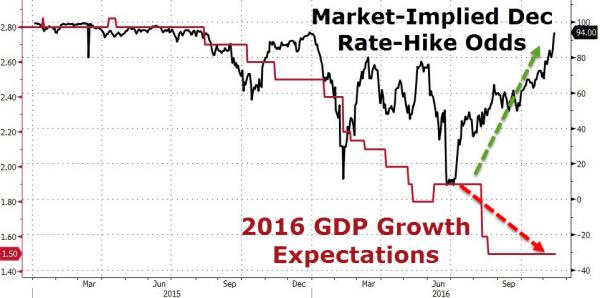Key Points:
- Markets are pricing in a near 100% chance of a hike.
- Jawboning likely following the decision.
- Fed likely to hike the FFR 25bps at December FOMC meeting.
The U.S. news cycle over the past few weeks has been primarily about the presidential election and subsequent result. So you would be largely forgiven for missing the fact that there is a looming risk event with the Fed’s FOMC set to meet in December to determine their monetary policy. Subsequently, it makes sense to take stock of the current key economic data points to assess the Fed’s likely decision in the weeks ahead.
A cursory review of the Treasury Yield curve certainly shows a near linear rise over the next two years with the Federal Funds Rate, based on forward looking expectations, forecasted to rise to around the 1.00% level within that time frame.
Even the futures markets are predicting a cycle of tightening with the latest Bloomberg figures showing the odds of a December rate hike nearing 100%. However, is a sustained cycle of tightening actually likely from the Reserve Bank? Or are we facing a return to the “data dependent” rhetoric from the central bank?

Taking a look at the U.S. economic fundamentals makes for a relatively messy read with growth continuing to be fairly lacklustre. In fact, growth expectations have continued to slide throughout the year despite the market’s view of increased rate hike probabilities. GDP growth expectations have been trending lower since early 2014 and seem to have flattened at around the 1.50% mark over the past quarter. In addition, inflationary pressures have been exceedingly mild over the same period and at no stage have looked like reaching the 2% targeted band.

Source: Zerohedge.com
In contrast, one of the bright spots of the economy has been the robust U.S. labour market which has continued to strengthen and subsequently neared the natural rate. However, average hourly earnings remain depressed and we are just not seeing the sort of wage inflation that the economy requires to support rising inflation and growth rates. In short, consumer expectations remain unmoved by the current gains in employment and consumption is unlikely to increase until some gains are made within wages.
Subsequently, you would be forgiven for asking just why the Federal Reserve is seeking to tighten their monetary policy when inflation is still largely absent and consumer sentiment remains under pressure. The reality is that given the uptick in employment, the Fed expected inflation to increase albeit with a lag. However, this has largely not been the case due to rises in the level of part time employment.
The reality is that the U.S. Federal Reserve has now backed themselves into a corner with their expectation setting advocating for rate hikes in 2016. Regardless of the current state of the U.S. economic recovery, the central bank is likely to hike the FFR 25bps at their December meeting, to retain their credibility and control over the expectations channel. However, similar to the rate hike in 2015, any decision to tighten will likely be a “one and done” and the bank will retreat to their mantra of “Data Dependent”.
Ultimately, in the post-GFC world, much has changed within the realms of Monetary Policy and the Fed is now grappling with the reality of diminished global growth along with the need to manage asset bubbles created by quantitative easing. Subsequently, although I am almost positive that the Fed will hike the FFR at December’s meeting, I doubt the veracity of any statements around a cycle of tightening because, at this stage, the broader economy simply doesn’t support it.
